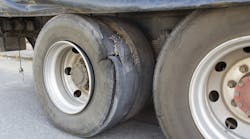When it comes to improving freight efficiency, some things just make sense. Take aerodynamic devices on tractors and trailers. There are big savings to be had by improving the aerodynamics on tractors and trailers. Basically, adding one or more aero devices is a no-brainer when it comes to improving freight efficiency.
I am beginning to think that tire pressure monitoring and/or tire pressure inflation systems on both tractors and trailers might also be a no-brainer. Proper tire inflation pressure is critical to the optimal operation of a commercial vehicle. Underinflated tires result in decreased fuel efficiency and increased tire wear. Tire underinflation leads to about a 5% to 12% degradation in tire wear for an individual tire which is 10 psi underinflated, and a 0.5% to 1% increase in fuel consumption. Studies have shown that about one out of every five tractors are operating with one or more tires underinflated by at least 20 psi; one in five trailers also is operating with one or more tires underinflated by at least 20 psi.
See also: Go slow, save fuel
I am not suggesting that you just rush out and purchase a tire pressure monitoring or tire pressure inflation system. But I am suggesting that you begin doing some due diligence to see if a monitoring or inflation system makes good sense for your operation. Of course, I know that very few freight efficiency measures are free. (However, some things like setting engine parameters, optimizing routing, and slowing down are, in fact, free.)
Tire pressure monitoring and tire pressure inflation systems don't fall into that free category, so you do need to perform a total cost of operation calculation before making the investment. When doing so, don’t forget to factor in the increased tire life you’ll get when your tires are at their proper inflation pressure. Low tire pressure causes premature tire wear. Also factor in the fact that you will likely have fewer roadside breakdowns when your tires are at their proper inflation levels. Very low tire pressure can cause a tire to rupture, resulting in a roadside breakdown.
Another good thing about these systems is that via telematics you can monitor tire condition remotely and then alert drivers and shop personnel about developing problems so they can be taken care of as quickly as possible.
See also: Electric trucks, their tires and wheels
The NACFE Confidence Report on Tire Pressure Systems incudes a payback calculator that you can use to help you determine if tire pressure inflation or tire pressure monitoring systems are a smart choice for your operation. Historical payback estimates for the implementation of tire pressure systems have ranged from less than one year up to about three years, with annual savings projected at $750 to more than $1,000 per vehicle per year.
Given those numbers, I think you can see why I am suggesting you make the investment. One more thing: When you invest in a system that monitors tire pressure, that is one less non-driving task you have to ask your drivers to do. Anything you can so to make your drivers’ lives easier is bound to have a big payback in driver retention.
Michael Roeth has worked in the commercial vehicle industry for nearly 30 years, most recently as executive director of the North American Council for Freight Efficiency (NACFE). He serves on the second National Academy of Sciences Committee on Technologies and Approaches for Reducing the Fuel Consumption of Medium and Heavy-Duty Vehicles and has held various positions in engineering, quality, sales, and plant management with Navistar and Behr/Cummins.



